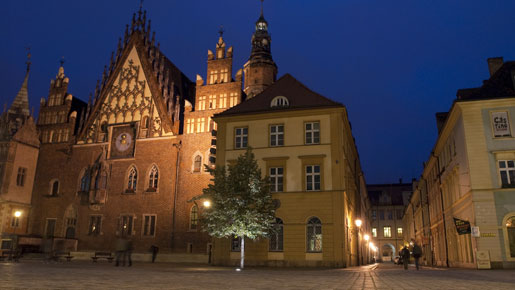
Located between Prague, Berlin and Warsaw, Wroclaw is undergoing an economic boom, powered in part, by a series of banner foreign investments.
But apart from becoming a popular hub for international business, the city is increasingly receiving recognition as a desirable conference destination. In 2005 – one year after Poland joined the European Union – 500 political officials gathered in Wrocław for the European Summit of Regions and Cities. A year later Wrocław hosted Futurallia, the prominent international business networking event. With 1,500 participants from 36 countries, the 2006 edition, which was the first time the event was held outside the French-speaking world, turned out to be the largest Futurallia in history.
A major pull for conference organisers is the historic Centennial Hall and exhibition grounds. With a capacity of 7,000 under one roof, this multifunctional facility can accommodate large, high-profile events.
At the time of its completion in 1913, Centennial Hall required superlatives to describe it. Not only was it the largest reinforced concrete structure in the world, it also featured the biggest dome to have been constructed since the Pantheon in Rome 18 centuries earlier.
In 2006, the hall was added to UNESCO’s list of World Heritage Sites as one of the most important achievements in twentieth Century architecture. Official dedication ceremonies with the participation of UNESCO Director-General Koïchiro Matsuura took place in Wrocław in June 2007.
Explore the region
One of the lures of visiting Wrocław is the easy access it offers to the historic sites and unspoiled nature of the surrounding province of Lower Silesia. Lower Silesia offers everything from rugged mountains to pristine lakes; from castles and monasteries to swank health resorts.
The Lower Silesia landscape is dotted with more than 160 castles and palaces. Some have been carefully restored and transformed into classy hotels and conference centres, while others function as museums that take visitors on fascinating journeys into the past.
The Sudety Mountains that skirt the border between Poland and the Czech Republic can be reached in 1.5 hours by car from Wrocław. In the fall when the visibility is high and forests are on fire with autumn colors, the Sudety’s peaks and trails tempt lovers of hiking, biking, rock climbing and paragliding.
A ‘must-see’ on any tourist agenda is at least one of the two Churches of Peace recently declared UNESCO World Heritage sites. Made exclusively from wood, clay and straw (no nails!), these richly decorated seventeenth century houses of worship continue to be poignant symbols of human ingenuity.
The hidden treasures of Lower Silesia are the abundant natural springs. The curative properties of the waters in the Lower Silesia spa towns were discovered as early as the Middle Ages. But the nineteenth century witnessed a boom in the spa business. Elegant and highly stylised hotel complexes and pump rooms where water could be sipped directly from the source provided ideal surroundings for refined convalescence and respite for even the most demanding strata of European elite. Today the atmosphere of the heydays is still evident in the eleven health resorts tucked in valleys near the border with the Czech Republic.
Essence of New Europe
Fresh. Authentic. Fascinating. Hospitable and professional. These are just some of the hallmarks of choosing Wrocław and Lower Silesia for your next conference or event. Convention Bureau-Wrocław invites you to explore the city and region, and remains available to assist you at all stages of your venture.

